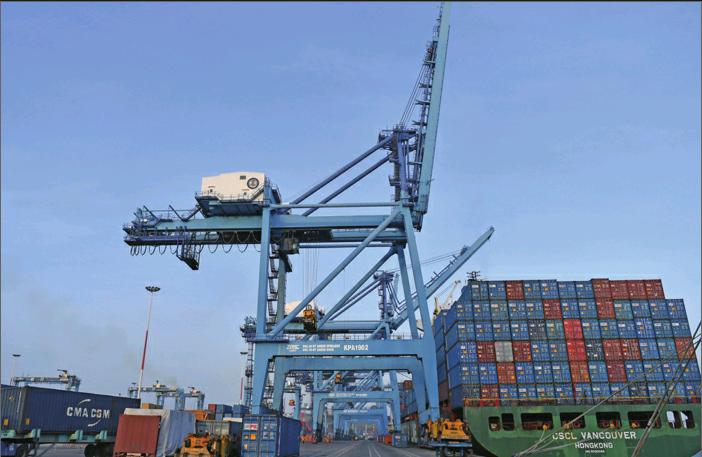INCLUSIVE APPROACH
2017-05-27ByCharlesOnunaiju
By+Charles+Onunaiju

The Silk Road Economic Belt and the 21st-Century Maritime Silk Road, better known collectively as the Belt and Road Initiative, Chinas twin global outreach development paradigms enunciated by Chinese President Xi Jinping in 2013 during his state visits to Kazakhstan and Indonesia, are up and running.
Originally designed as a Eurasian transport network and integrated system that is composed of railways, highways, aviation, navigation, oil and gas pipelines, transmission lines and communication networks from which industrial clusters would emerge, it has become a globally inclusive framework.
The Belt and Road Initiative is today taking shape as a trans-regional cooperation model connecting Asia, Africa and Europes policies, trade, facilities, funds and people in the 21st century.
According to the document Vision and Actions on Jointly Building Silk Road Economic Belt and 21st-Century Maritime Silk Road co-released by Chinas National Development and Reform Commission, Ministry of Foreign Affairs and Ministry of Commerce in 2015, the joint construction of the Belt and Road is “aimed at promoting orderly and free flow of economic factors, highly efficient allocation of resources and deep integration of markets, encouraging the countries along the Belt and Road to achieve economic policy coordination and carry out broader and more in-depth regional cooperation of higher standards, and jointly creating an open, inclusive and balanced regional economic cooperation architecture that benefits all.”
Many initiatives
The initiative has already amassed huge international goodwill with the participation of more than 100 countries and organizations in a cooperation arrangement that is open, inclusive, balanced and beneficial for all.
Originally, the coast of East Africa, where the famous Chinese sailor Zheng He traveled over 500 years ago to inaugurate the historical precursor to contemporary China-Africa cooperation and friendship, was the only part of Africa covered in the traditional Maritime Silk Road.
However, in the new, up and running framework of the Belt and Road Initiative, the whole of Africa is well within the open and inclusive process. The critical challenge of infrastructure network to complement the long-held aspiration for a united and integrated Africa has found a practical and powerful impetus in the China-driven international cooperating framework. Free of a grand institutional behemoth-like separate secretariat and formal red tape, the Belt and Road Initiative will be anchored on existing regional and international mechanisms, a far cry from building another global or regional bureaucracy.
With a growing presence in Africa, China is engaged in the construction of the physical framework for integration. The port of Mombasa in Kenya has reached an advanced stage of completion, and the MombasaNairobi standard gauge railway line, which would connect to Uganda, South Sudan and through to Rwanda, is up and running. The long-drawn East African economic integration that would boost the sub-regions economies of scale will gain practical momentum with the trans-regional rail line.
Meanwhile, Ethiopia, a growing industrial hub, initially hobbled by a deficit of port access, is now connected through Africas first modern electrified railway to the Port of Djibouti. The Tanzania-Zambia Railway built in the 1970s with Chinas assistance as an enduring monument of China-Africa friendship is due for rehabilitation, with China, Zambia and Tanzania working in cooperation. Through a comprehensive reform of the management system, effectively linking the railway to ports and building an industrial economic belt along the railway, it is hoped that the 1,860-km railway line will gain fresh vigor and help Tanzania, Zambia and other African countries boost independent, inclusive and sustainable development.
Nigeria, one of the largest economies of Africa, is on the cusp of an infrastructure revolution as China deepens its engagement in that vital and value-creating chain. The Abuja-Kaduna standard gauge railway is up and running, and at the ceremony to launch the Lagos-Ibadan rail line which would connect the northern commercial hub of Kano, Vice President Oluyemi Osinbajo called China Nigerias most reliable friend. The production capacity cooperation with Nigeria is in top gear.
Elsewhere in Nigeria, the Lekki Free Trade Zone, an incubating hub of Nigerias reindustrialization efforts, is receiving a massive boost from comprehensive Chinese participation. At a recent seminar at the free trade zone, Chinese Ambassador to Nigeria Zhou Pingjian said “As the worlds largest manufacturing country and second largest economy, China sincerely hopes to share its experience with Nigeria and stands ready to provide capital, technology and personnel in support of Nigerias industrialization.” Zhou added that China supports the relocation of labor-intensive industries to Nigeria on a priority basis and the localization of Chinese companies to create more non-agricultural jobs, especially those suited to young people.
Inclusive process
Already China has expended over 50 percent of the $60 billion given to fund projects in the 10 cooperation plans outlined by President Xi at the Johannesburg Summit of the Forum on China-Africa Cooperation held in South Africa in December 2015.
The good news is that the process of China and Africa deepening engagement on the decisive infrastructure challenge of the continent will receive a massive boost and will be further mainstreamed in the framework of the Belt and Road Initiative.
The initiative is both an all-round open- ing-up program and an international plan along with public goods under the principle of wide consultation, joint contributions and shared benefits, all aimed at establishing a community with shared destiny.
With the framework of the Belt and Road Initiative, China has led the establishment of the Asian Infrastructure Investment Bank (AIIB) for which more than 60 countries, including rich industrialized member countries of the Organization for Economic Cooperation and Development (OECD), have signed up. The Silk Road Fund is disbursing funds for projects earmarked in the process.
Africas funding deficit could be considerably ameliorated if the regions governments strategically engage with the global public goods, generously offered by the Belt and Road Initiative. Importantly, the initiative does not have the geopolitical trappings seen in the Marshall Plan through which the United States helped post-World War II Western Europe to reconstruct and recover, but locked it into U.S. strategic national security interests, a burden which fuels the debate about the future of the North Atlantic Treaty Organization.
Benefiting youth
The connectivity implicit in the Belt and Road Initiative is to boost people-to-people contact. As the network of infrastructure connectivity will be complemented by industrial clusters and other economic activities, the initiative is expected to soak in a large army of young people in Africa, both in the formal and informal sectors of the economy. Not only would transportation duration be considerably cut, but the network arteries would feature a booming informal service sector. Young people attracted to anti-social behaviors, including criminality and extremist insurgencies, would be absorbed into productive and economic activities.
In short, the Belt and Road global integration process has enormous potential to solve the practical problems of unemployment in Africa.
